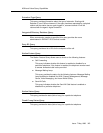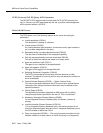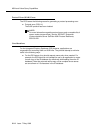
ASAI and Value Query Capabilities
9-8 Issue 7 May 1998
— Dialing (initiate): A station on the call is off-hook originating a call or listing
to dial tone.
— Alerting: The call is alerting (ringing). This also includes calls at simulated
bridges of stations that are ringing.
— Connected (active): A call is active at the station (talking state). This
includes active calls at a bridged or simulated bridged appearance.
— Held: A call that was put on hold.
— Bridged: A call is present at a bridged, simulated bridged, button TEG, or
PCOL appearance, and the call is neither ringing nor connected (active) at
the station.
— Other: All other call states, including conference pending, listening to tone,
and so forth.
party_id list provides a party identifier for the station on each of the calls. Note
that there is a one-to-one correspondence between the elements of this list and
the above two lists (call_id and call_state list).
Call Classifier Status Query ACK Parameters
The ECS responds with the number of “idle” and “in-use” ports that are capable of
call classifiers. The “in-use” number is a snapshot of the port usage.
Starting with R5, if the USA Default Algorithm? field is set to
n
on the System
Parameters OCM Call Classification form, this query will provide the total number
of ports for the TN744D and TN2182B boards (and any later versions) that are
idle and in-use. If
y
is entered in this field, the query will provide the total number
of idle and in-use ports for all the TN744 and TN2182 boards.
Date/Time of Day ACK Parameters
The ECS response contains the year, month, day, hour, minute, and second.
Extension Type Information Query ACK
Parameters
The ECS responds with the following information:
Extension_class specifies the extension number as:
■ Vector Directory Number (VDN)
■ Hunt group (ACD split)
■ Announcement
■ Data extension


















